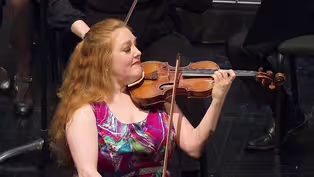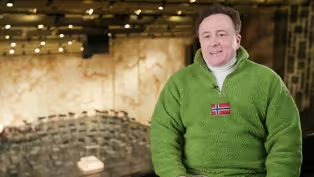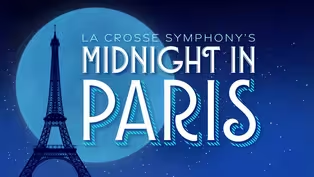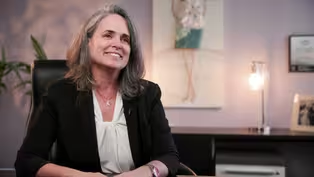PBS Wisconsin Music & Arts
A conversation with classical violinist Rachel Barton Pine
Clip: Special | 5m 32sVideo has Closed Captions
Barton Pine discusses her historic violin and approach to writing personal cadenzas.
Rachel Barton Pine discusses her collaboration with the La Crosse Symphony and Maestro Alexander Platt, her 1742 Guarneri del Gesù violin previously used by Antonio Bazzini and Marie Soldat and her philosophy on writing personal cadenzas rather than using traditional ones by virtuosos like Joachim and Kreisler.
Problems playing video? | Closed Captioning Feedback
Problems playing video? | Closed Captioning Feedback
PBS Wisconsin Music & Arts is a local public television program presented by PBS Wisconsin
PBS Wisconsin Music & Arts
A conversation with classical violinist Rachel Barton Pine
Clip: Special | 5m 32sVideo has Closed Captions
Rachel Barton Pine discusses her collaboration with the La Crosse Symphony and Maestro Alexander Platt, her 1742 Guarneri del Gesù violin previously used by Antonio Bazzini and Marie Soldat and her philosophy on writing personal cadenzas rather than using traditional ones by virtuosos like Joachim and Kreisler.
Problems playing video? | Closed Captioning Feedback
How to Watch PBS Wisconsin Music & Arts
PBS Wisconsin Music & Arts is available to stream on pbs.org and the free PBS App, available on iPhone, Apple TV, Android TV, Android smartphones, Amazon Fire TV, Amazon Fire Tablet, Roku, Samsung Smart TV, and Vizio.
[gentle orchestral music] - Rachel Barton Pine: I was last with the La Crosse Symphony in October of 2016, when we collaborated on the third violin concerto of Camille Saint-Saens.
And so it's wonderful to be back, but actually, my collaboration with Maestro Alexander Platt goes much farther back than that.
We actually collaborated on my 2004 album, Scottish Fantasies, recorded with the Scottish Chamber Orchestra, all of these wonderful, Scottish-flavored, serious concertos for violin and orchestra.
And even though I've made dozens of recordings since then, it seems to be a perennial popular favorite with the public.
And so it's always fun to reunite with Alexander because I just love his musicianship, his passion for music.
His dedication and commitment.
It's always wonderful to work with a musician who just loves music so much.
So this violin was made in the year 1742 by Guarneri del Gesu of Cremona, Italy.
Guarneri and Stradivari are considered to be the two greatest makers ever.
And it's really just a matter of taste, which one you prefer.
I'm very lucky to be using this one.
It's called the ex-Bazzini, ex-Soldat after two of the great artists who played it in the past, Antonio Bazzini, a early 19th century Paganini-style virtuoso, and then Marie Soldat, one of the women violin soloists of the late 19th and early 20th centuries.
So it's amazing to play Brahms' music on an instrument that was one of the first instruments to ever play the Brahms Concerto.
And it's just such an honor to be able to play this violin.
It not only does everything that I could possibly imagine, but it even suggests things to me that I would've never thought of.
[gentle violin music] Often in violin concertos, there are moments when the violin is playing all by itself.
It's a little bit equivalent to the guitar solo in a rock song, except that in the case of cadenzas, the instrumentalist is completely alone, but they are playing some, you know, just fooling around with the different arpeggios and stuff, playing derivations of material that's been heard in the music heretofore.
And in the olden days, in the time of Mozart, people used to actually improvise their cadenzas based on, you know, general rules of how one does that, but, you know, just kind of make it up on the spot.
Very few people do that these days.
I think primarily because we're playing so many different styles of music, even if all we do is classical, we're playing music from many, many different centuries and countries, and so we're not as steeped in just one narrow musical language like they were in the late 1700s.
[bright violin music] Brahms was really one of the last concertos ever written for violin, where there was this big pause with a cadenza opportunity.
And so, of course, the very first performer of the concerto, Joseph Joachim, his dedicatee, wrote a cadenza, and many people will play Joachim's cadenza.
But there's nothing more personal than writing your own cadenza, because each of us as performers plays each concerto slightly differently based on not only the traditions of the time and what we believe to be the composer's intentions, but also based on our own individual personality.
Each of us is unique as a human, and so therefore only your own cadenza can be truly integrated with your own interpretation.
And so, when I was younger, I used to worry that, gosh, if I write a cadenza, it might not be as good as the classic ones by Joachim and Kreisler.
And then I realized I was looking at it all wrong, that only my cadenza could be the truest to myself, and it's not about comparing mine to anybody else's 'cause only mine is the most me.
And therefore, I always try to encourage young artists to write their own cadenzas, because it's just such a fun way to personally express yourself in music.
[gentle orchestral music] It's a great way to be creative and also to give something a little bit fresh to the audience that they haven't heard before, even if they've heard the Brahms concerto a million times.
[gentle orchestral music] I feel so incredibly lucky to be living my dream, really.
This is the life I always wanted to have, being able to play lots of concerts for people, and in the concert halls and beyond.
I have a concert next week at a homeless shelter, and that means just as much as a big 1,000-seat concert hall.
And being able to uplift people's spirits with music is what it's really all about.
And then being able to encourage the next generation and explore different repertoire, whether it's newly-written pieces or historic things that have been heretofore under-recognized.
It's just so exciting to be able to get to do all that I do.
And it's just so amazing that I get to live my life this way.
[ending note]
Video has Closed Captions
Clip: Special | 42m 45s | Classical violinist Rachel Barton Pine performs Brahms Violin Concerto in D Major. (42m 45s)
A conversation with Maestro Alexander Platt
Video has Closed Captions
Clip: Special | 4m 44s | Alexander Platt reflects on 15 years leading the La Crosse Symphony. (4m 44s)
Preview - La Crosse Symphony's Midnight in Paris
Preview: Special | 30s | Take your seat for a performance of works by one of France’s most acclaimed composers. (30s)
A 'special relationship' with La Crosse
Video has Closed Captions
Clip: Special | 2m 25s | Eva Marie Restel on the relationship between the orchestra and the community of La Crosse. (2m 25s)
Providing Support for PBS.org
Learn Moreabout PBS online sponsorshipSupport for PBS provided by:
PBS Wisconsin Music & Arts is a local public television program presented by PBS Wisconsin



















